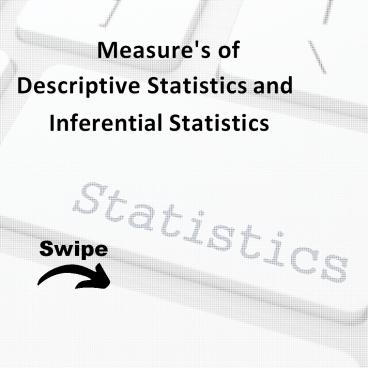Measures of Descriptive statistics and Inferential statistics - PowerPoint PPT Presentation
Title:
Measures of Descriptive statistics and Inferential statistics
Description:
The presentation will walk you through descriptive and inferential statistic measures, including a simple scenario, key measures and applications of descriptive and inferential statistic's. – PowerPoint PPT presentation
Number of Views:122
Title: Measures of Descriptive statistics and Inferential statistics
1
Measure's of Descriptive Statistics and
Inferential Statistics
Swipe
2
Introduction
25
Descriptive statistics are numbers that
are used to summarize and describe
20
data. The word "data" refers to the information
that has been collected from an experiment, a
survey, a historical record, etc.
15
10
5
0
Item 1
Item 2
Item 3
Item 4
Item 5
50
Inferential statistics is a set of data taken
from the population to represent the population.
Inferential statistics uses a random sample of
data taken from a population to describe and
make inferences about the population.
40
30
20
10
0
Item 1
Item 2
Item 3
Item 4
Item 5
3
Example
Descriptive statistics
Raw data
Descriptive statistics
Inferential statistics
4
Measures of Descriptive Statistics
Frequency distribution Measures of central
tendency Measures of position Measures of
variability Graphical representation
Correlation co-efficient
5
Measures of Inferential Statistics
Non- Parametric
Parametric
T-test ANOVA
Kolmogrov-smirnov Mann-whitney Median Spearman
rank correlation
Chi-square
6
Applications of Descriptive Statistic
It gives information that describes the data in
some detailed manner. Organize, analyze and
present data in a meaningful way. To describe a
situation. Descriptive statistic are concerned
with describing the characteristics of frequency
distribution. Charts, graphs and tables.
7
Applications of inferential Statistic
- To makes inferences about population using data
drawn from the population. - To compare data, text hypothesis and make
predictions (Estimation or parameters). - To explain the chance of occurrence of an event.
- It attempts to reach the conclusion to learn
about the population.
8
Topics for next Post
Measure of Central Tendency Measure of
variability Hypothesis Test, Confidence
Interval and Regression Analysis Stay Tuned with






























